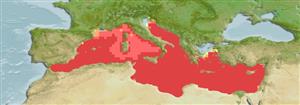Common names from other countries
Environment: milieu / climate zone / depth range / distribution range
Ecología
marino; oceanodromo (Ref. 51243); rango de profundidad 0 - 200 m (Ref. 43). Deep-water; 46°N - 30°N, 6°W - 36°E (Ref. 43)
Mediterranean Sea: considerably abundant around Italy. No confirmed report from the Black Sea. No adults have been reported east of the Ionian Sea. Highly migratory species. Reportedly caught from the Aegean Sea (Pennetti, pers. comm.).
Tamaño / Peso / Age
Maturity: Lm ? range ? - ? cm
Max length : 240 cm TL macho / no sexado; (Ref. 4770); common length : 200 cm OT macho / no sexado; (Ref. 43); peso máximo publicado: 70.0 kg (Ref. 43)
This species is the most common istiophorid in the central basin of the Mediterranean and completes its life cycle inside this sea as far as is known to date. Probably swims in the upper 200 m water layer, generally above or within the thermocline. Travels in pairs, possibly corresponding to a feeding behavior. Feeds on fishes. Probably more widespread in the Mediterranean Sea and may have been identified as T. albidus by anglers and fishermen.
Life cycle and mating behavior
Madurez | Reproducción | Puesta | Huevos | Fecundidad | Larva
Winter and spring might not be an unreasonable hypothesis for the spawning season of this species.
Nakamura, I., 1985. FAO species catalogue. Vol. 5. Billfishes of the world. An annotated and illustrated catalogue of marlins, sailfishes, spearfishes and swordfishes known to date. FAO Fish. Synop. 125(5):65p. Rome: FAO. (Ref. 43)
IUCN Red List Status (Ref. 130435)
CITES (Ref. 128078)
Not Evaluated
Threat to humans
Harmless
Human uses
Pesquerías: escaso valor comercial
Más información
ReferenciasAcuiculturaPerfil de acuiculturaRazasGenéticaElectrophoresesheritabilidadEnfermedadesProcesamientoMass conversion
ColaboradoresImágenesStamps, Coins Misc.SonidosCiguateraVelocidadTipo de nataciónSuperficie branquialOtolitosCerebrosVisión
Herramientas
Special reports
Download XML
Fuentes de Internet
Estimates based on models
Preferred temperature (Ref.
115969): 13.7 - 19.3, mean 15.3 (based on 121 cells).
Phylogenetic diversity index (Ref.
82804): PD
50 = 0.5630 [Uniqueness, from 0.5 = low to 2.0 = high].
Bayesian length-weight: a=0.00447 (0.00193 - 0.01034), b=3.14 (2.94 - 3.34), in cm Total Length, based on LWR estimates for this (Sub)family-body shape (Ref.
93245).
Nivel trófico (Ref.
69278): 4.4 ±0.63 se; based on food items.
Resiliencia (Ref.
120179): Bajo, población duplicada en un tiempo mínimo de 4.5-14 años (Assuming tmax>10).
Fishing Vulnerability (Ref.
59153): Very high vulnerability (90 of 100).
